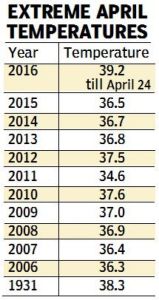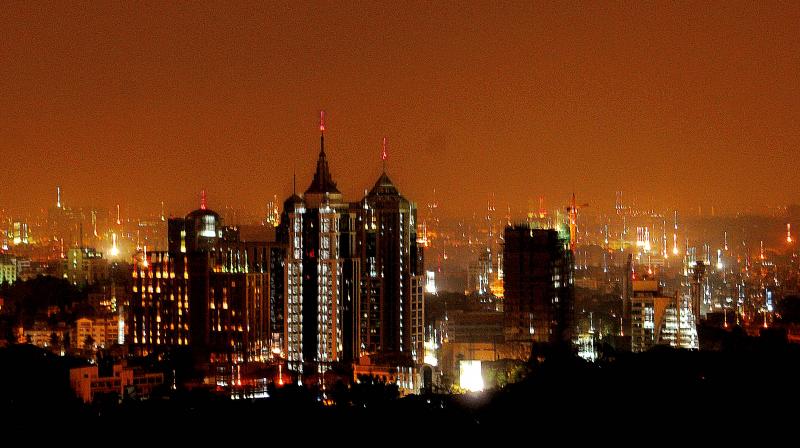By Shravan Regret Iyer
The average temperature in Bengaluru was 19.03 degree Celsius in 1992 and has risen rapidly since to the mid-30s level now. Before the skies opened up on Monday, the mercury hit the highest ever at 39.2 degree Celsius on Sunday. The reasons are not far to seek. Indiscriminate building activity since the 1990s, thanks to lax enforcement of norms by city authorities, has shorn Bengaluru of both its vegetative cover and its water bodies, creating heat islands all across the city. Concurrently, unregulated migration into the city has resulted in rising greenhouse gas emissions from vehicles and households. Is this what we wanted in the name of development? Or, have the authorities we entrust the city to, failed us?
Welcome showers may have finally arrived Monday to cool Bengaluru, but the city has been on the boil for much of this summer, with the trend starting as early as March. And to top it all, Sunday saw its temperature soar to a never before seen 39.2 degree Celsius, breaking the April 30, 1931 record of 38.3 degree Celsius for the hottest day the city has ever experienced.
Boasting of being an “airconditioned city,” for long , Bengaluru is having to wake up to a new reality now. Many of its people, who have never felt the need for airconditioners even in summer, are now queuing up to install them in their homes and offices to beat the heat. While the meteorological department blames the unusually hot summer the city is experiencing this year on delay in cloud formation and April showers that usually arrive to cool it, scientists of the Indian Institute of Science believe the increasing concretisation of the city is also to blame. “There has been a 925 per cent increase in the city’s built- up area since 1973 and this is causing a rise in its temperature,” says Dr T. V. Ramachandra of the institute’s Centre for Ecological Sciences (CES).

If the IT boom of 1995-96 changed the “Pensioners’ Paradise” to the Silicon Valley of India, the consequent development has unfortunately impacted its weather. With over one crore sq. ft. of office space and huge apartment complexes occupying double that space in two decades, the city’s degeneration is visible for all to see. More so as it has lost 78 percent of its vegetation and 79 per cent of its water spread since 1973, going by the CES researchers.
“Protection of the ecosystem is very important in a city like Bengaluru as its water bodies and tree cover act as heat sinks. But with increased urbanization, the city has lots much of its greenery,” notes Dr Ramachandra, who has prepared a research paper titled ‘Greater Bengaluru: Emerging Heat Islands,’ with a team of his scientists from the CES.
The paper points out that the city’s temporal heat has changed drastically since 1992 when it was just 19.03 degree Celsius. It rose to 26.57 degree Celsius and then 31.24 degree Celsius in 2007. “It is clear that urban areas that include commercial, industrial and residential exhibit the highest temperature, while the lowest temperature is seen on water bodies and around vegetation,” it reads.

The city’s high- rise buildings, many with a glass façade, are not helping matters either, says Dr Ramachandra. “Buildings covered in glass absorb more heat and so more power is spent on keeping their interiors cool. We have found that for a normal building the electricity consumption is 750 to 1200 units per person, but it is 14, 000 to 17, 000 units per person in a glass façade building,” he reveals.
The scientists also hold the increased emission of green house gases in the city responsible for creating the heat islands that have become so hard to take for Bengalureans used to a more balmy weather even in summer. The city emits 2.18 t CO2 equivalent emissions per capita and the major contributors are the transportation sector ( 43.5 per cent) domestic sector ( 21.6 per cent and industrial sector (12.31 per cent) in greater Bengaluru, they add.
Former environment secretary, Dr A N Yellappa Reddy too believes urban heat islands are contributing to the hot weather in the city and suggests that it should measure its ground level ozone to check further pollution before it is too late. “When hydrocarbon, nitric oxide and sunlight together split oxygen available in the ambient air, a secondary pollutant called ground level ozone is formed.
Unlike the ozone layer in the stratosphere, this ozone layer kills all living beings including humans,” he explains. Noting that many European countries have already installed sensors to keep a tab on the ground level ozone, and limit the vehicular movement in an area, where it is more than permissible, he suggests Bengaluru needs to do the same in the interest of its environment and people’s health.
Higher population density also a factor
Ranked 19th in the list of the world’s most populated cities, Bengaluru has 10,100 people per sq km. While The IT boom of 1995 saw an increase in migrants to it, the last decade has seen its population grow by 47 per cent owing to rise in job opportunities and economic growth. Today Bengaluru has over six lakh properties in 198 wards under eight zones of the Bruhat Bengaluru Mahanagara Palike (BBMP).
Urban heat islands
Bengaluru is believed to be getting hotter due to the creation of urban heat Islands. The term refers to an area that is significantly warmer than its surroundings due to human activity. Increase in high- rise buildings and the dispersion of smog, heavy metals, and suspended particulate matters due to more vehicles on the roads are contributing to its creation in the city. Surface and atmosphere temperature rises due to anthropogenic heat discharged as a result of energy consumption, increased land surface coverage by artificial material that absorbs more heat, and the associated decrease in vegetation and water surfaces, which reduce surface temperature.
Is El Nino to blame too?
The weathermen say Sunday’s record high temperature was not just due to the El Nino effect, but also due to the delay in cloud formation and rainfall in the city. El Nino is a condition in the equatorial Pacific Ocean, off the coast of Ecuador and Peru in South America, which sees the sea surface become unusually warm. It is accompanied by high air pressure in the western Pacific and low air pressure in the eastern Pacific. El Nino has always been a bane for India, note weather experts.
Violations in town planning
Researchers at the Indian Institute of Science say the city’s temperature may have also risen due to the violations in town planning, which have left it with few open spaces. “The authorities are supposed to reserve 15 per cent of the open area for a green space when planning new layouts, but this has often been violated,” regrets Dr TV Ramachandra of the institute’s Centre for Ecological Sciences.
Loss of water bodies
Researchers from the Indian Institute of Science (IISc) have found that 54 per cent of lakes in the city are encroached by illegal constructions that have blocked their natural catchment flow, leading to sharp decline and a deterioration in the quality of the water bodies. An India Water Portal study also shows that the city has also lost over 200 tanks since 1960. The sprawling Majestic and Kanteerava bus stand have replaced water tanks.
This story was originally published in Deccan Chronicle Apr 26, 2016, edition
